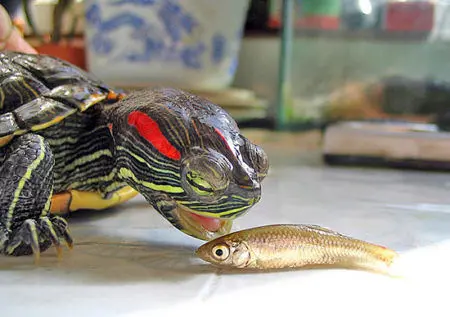Contents
How to feed a domestic turtle depends on its species. They can be carnivores and vegetarians. There are species that are gradually switching to a plant-based diet.
Food for domestic turtles of carnivorous species
Most aquatic turtles are classified as predators. In nature, they feed on small fish, crustaceans, molluscs, and caviar. Some species become either omnivorous with age, or switch completely to plant foods. For home keeping, small individuals are chosen and kept in special terrariums.
Predatory Reptile Menu:
- raw gammus;
- tubifex;
- bloodworm;
- locusts;
- crickets;
- forage cockroaches;
- caterpillars and larvae;
- earthworms;
- frogs and tadpoles;
- snails;
- small live fish, such as guppies;
- raw shrimp;
- raw fish;
- beef liver;
- forage mice.
The diet of a predatory turtle is determined by its age and needs. The owners need to ensure the variety and balance of the menu. There should be enough nutrients in the diet, especially calcium. To maintain balance, you need to regularly give vitamin supplements. Make sure that the food pieces are completely eaten, otherwise they will start to rot and spoil the water in the terrarium.
Food for the domestic grass turtle
Most terrestrial and some aquatic reptiles are herbivores or omnivores. Including widespread – Central Asian. They should receive up to 95% of plant food, the rest, the protein part, is needed for the growth and development of bones. Be sure to give extra vitamins and calcium.
Diet of the herbivorous turtle:
- in the summer, you can collect wild-growing grass, pluck it away from the roads and wash it thoroughly;
- vegetable tops and sprouts such as beets, cabbage, carrots;
- soft meadow hay;
- sometimes you should give pieces of boiled egg and scalded fish;
- fruits – apples, pears, bananas, citrus fruits;
- vegetables – carrots, cucumbers, zucchini, cabbage, beets, broccoli;
- berries – strawberries, raspberries, currants, peaches, apricots;
- dried fruits.
Any plant or fruit must be thoroughly washed with soap or soda before giving it to a pet. In the summertime, turtles can be taken out to “graze”. For a walk, it is better to choose a closed courtyard, a fenced lawn or a personal plot.
Feeding and other care of a domestic turtle is so easy that even a small child can handle it. This is an unpretentious, long-lived pet.
NUTRITION OF HERBIVOROUS TURTLES
A fairly large group of turtles are herbivores. These are all land turtles, as well as such breeds as: Mediterranean, Central Asian flat, radiant, Greek and others.
Of course, plant foods should prevail in the diet of such pets. Turtles will be happy to eat unsweetened vegetables and fruits, plants, berries.

80% of the diet can be salads, leaves and edible flowers. Offer your pet: clover, plantain, dandelions, alfalfa, lettuce, cucumbers, pumpkin, zucchini, apples.
Ready-made feeds are now on sale, which include all the necessary nutrients and trace elements. You can buy food for turtles at any Zoo Gallery store .
OMNIVOROUS TURTLES
This type of turtle includes aquatic, semi-aquatic, as well as individual subspecies of land reptiles, for example: marsh, prickly, red-eared, red-footed. For these pets, it is necessary to draw up a balanced menu, which will include both plant and animal food in equal proportions.
It can be: algae, plants, vegetables, salads, fruits, chicken meat.
PREDATORY TURTLES
The diet of these pets is 90% meat. Trionyx turtles, aquatic and young red-eared turtles, as well as marsh turtles, belong to this species.

These pets need to be offered lean fish, beef, chicken, fish liver. Adults can eat large pieces, it is better for young turtles to cut the meal into smaller ones.
Turtles eat seafood raw; fish also does not need to be thermally processed.
Pork, beef, sausage, minced sausage, cheeses, bread, fruits and fatty fish for predatory turtles are prohibited. It is best to feed with ready-made dry food.
HOW OFTEN SHOULD TURTLES BE FED
Another question that often worries tortilla lovers is how many times a day to feed the turtle. Regardless of the type of your pet, you need to feed the turtle twice a day, at the same time. Decide when it’s best for you to feed your turtle in the morning and evening, and stick to that schedule.
COMMON MISTAKES IN TURTLE NUTRITION
For novice turtle owners, it is very important not to make a mistake with the diet of your pet. After all, the correct composition of nutrients is necessary for the animal to form a strong shell, as well as growth and activity. It is very important for the tortilla body to get calcium and vitamins.
Of the prohibited foods: eggs, bread and milk, as well as beans, peas, white cabbage. Do not offer the turtle: tomatoes, radishes, radishes, garlic, herbs, nuts, cherries.
Turtles can usually go quite a long time without food. But if suddenly your pet refuses the offered food, it is best to take him to the veterinarian.
https://www.youtube.com/watch?v=HxZ92OAhsgY









